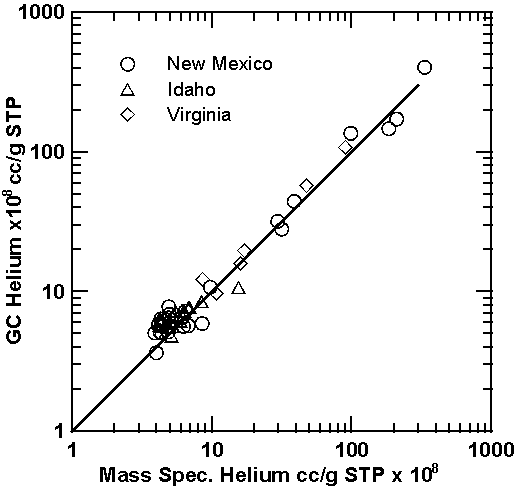Measurement of dissolved helium in ground water
This service is offered by the lab on a pre-arranged basis. Please email cfc@usgs.gov to arrange the service.
Dissolved Helium sample collection procedure
There are many reasons to measure helium in ground water, but as it applies to ground-water dating, there are two important reasons:
Helium accumulation in ground water can be an indicator of ground water age (see for example: Andrews and Lee, 1979; Heaton, 1984; Torgersen and Clarke, 1985; Andrews, 1985; Stute et al., 1992; Solomon et al. 1996; Castro et al, 1998a,b; Castro et al, 2000; Busenberg and Plummer, 2000). If a local helium accumulation rate can be determined, it may be possible to estimate ages of waters that exceed 100 years to tens of thousands of years based on helium accumulation.
Helium analyses can be used to screen samples collected for 3H/3He dating that may contain large excesses of terrigenic helium (helium of mantle and/or crustal origin), and ultimately cannot be dated. This problem occurs primarily in samples that are mixtures of old water and recent recharge. The 3H/3He method can be applied to date the young fraction only if the sample is not contaminated with a large excess of terrigenic helium from the old fraction (see for example Plummer et al, 2000). The relatively low-cost gas-chromatographic analysis of helium prior to submittal of samples for 3H/3He analysis can result in a significant cost savings.For samples with high terrigenic helium, the 3He/4He ratio of the terrigenic helium must be known for the sample within 1% or better to permit reliable 3H/3He dating of the young fraction. Water in equilibrium with air normally contains about 4.6x10-8 ccSTP/g water of helium. Depending on the source, helium excesses of even 50% over air-water equilibrium can create large uncertainties in 3H/3He dating, such as in areas where the old fraction contains mixed mantle and crustal helium sources (Plummer et al, 2000). In other cases, the excess helium may be primarily of radiogenic origin (typically the 3He/4He ratio of 2x10-8 can be assumed) and samples containing helium excesses of even several hundred percent may be datable by the 3H/3He method.

Comparison of dissolved helium determined by mass spectrometry on samples collected in pinch-off copper tubes with helium determined by gas chromatography on water samples collected in septum bottles without headspace and analyzed at the Reston GW Dating Laboratory. Agreement of the GC measurements is generally within 20% of the mass spectrometric measurements.
Selected References
Andrews, J. N., The isotopic composition of radiogenic helium and its use to study groundwater movement in confined aquifers, Chem. Geol., 49, 339-351, 1985.
Andrews, J.N., and Lee, D.J., 1979, Inert gases in groundwater from the Bunter Sandstone of England as indicators of age and paleoclimatic trends. Jour. Hydrology, v. 41, p. 233-252.
Busenberg E., and Plummer, L.N., 2000, Dating young ground water with sulfur hexafluoride: Natural and anthropogenic sources of sulfur hexafluoride. Water Resources Research, v. 36(10), 3011-3030.
Castro, M.C., Stute, M., and Schlosser, P., 2000, Comparison of 4He ages and 14C ages in simple aquifer systems: implications for groundwater flow and chronologies. Applied Geochemistry, v. 15, p. 1137-1167.
Castro, M.C., Jambon, A., deMarsily, G., and Schlosser, P., 1998a, Noble gases as natural tracers of water circulation in the Paris Basin, 1. Measurements and discussion of their origin and mechanisms of vertical transport in the basin. Water Resour, Res., v. 34(10), p. 2443-2466.
Castro, M.C., Goblet, P., Ledous, E., Violette, S., and de Marsily, G., 1998b, Noble gases as natural tracers of water circulation in the Paris Basin, 2. Calibration of a groundwater flow model using noble gas isotope data. Water Resour, Res., v. 34(10), p. 2467-2483.
Heaton, T.H.E., 1984, Rates and sources of 4He accumulation in groundwater. Hydrological Sciences - Journal, v. 29, 29-47.
Plummer, L.N., Rupert, M.G., Busenberg, E., and Schlosser, P., 2000, Age of irrigation water in ground water from the Eastern Snake River Plain aquifer, south-central Idaho. Ground Water, 38(2), 264-283.
Solomon, D.K., A. Hunt, and R.J. Poreda. 1996. Source of radiogenic helium 4 in shallow aquifers: Implications for dating young groundwater. Water Resources Research 32, no. 6, 1805-1813.
Stute, M., Sonntag, C., Deak, J., and Schlosser, P., 1992, Helium in deep circulating groundwater in the Great Hungarian Plain: Flow dynamics and crustal and mantle helium fluxes. Geochim. Cosmochim. Acta, v. 56, p. 2051-2067.
Torgersen, T., and Clarke, W.B., 1985, Helium accumulation in groundwater, I: An evaluation of sources and the continental flux of crustal 4He in the Great Artesian Basin, Australia. Geochim. Cosmochim. Acta, v. 49, p. 1211-1218.